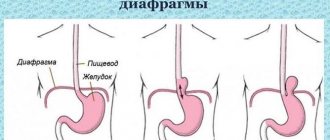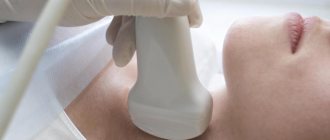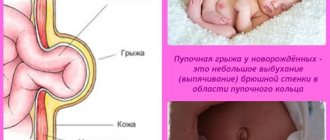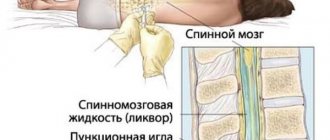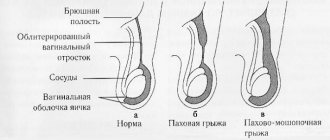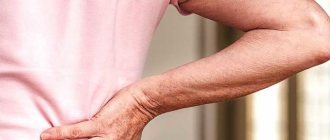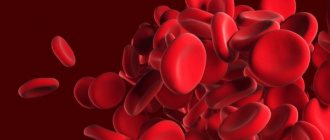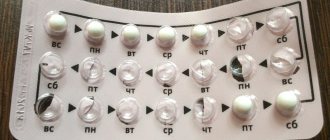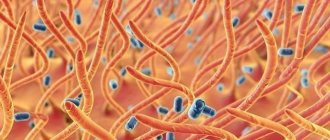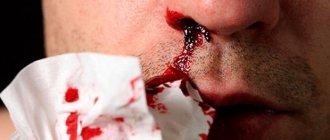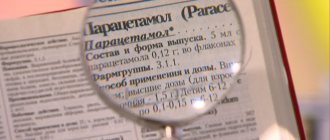What is a hernia?
A hernia forms when part of an organ or tissue in the body (such as a loop of intestine) protrudes through a hole or weakened area in a muscle wall and begins to protrude into a space where it should not be.
This protrusion is a hernia, which looks like a cord or lump. Some anatomical structures that function in utero and heal after birth do not have time to close. And babies are born with various small holes inside their bodies. Nearby tissue can penetrate such structures, forming hernias.
Unlike hernias found in adults, these areas are not always considered a weak area in the muscle wall. This is a normal, healthy part of the body that has not yet had time to go through all the stages of its extrauterine development.
Sometimes tissue can be compressed in the anatomical openings of the muscle wall, which are intended only for the passage of arteries or nerve trunks. In other cases, stress or injury weakens or thins a specific area in the muscle wall. And if any organ or part of it ends up in this place, the pressure it creates can also form a hernial protrusion.
How does a doctor make the correct diagnosis?
A pediatric surgeon will diagnose the child. He will take into account:
- symptoms of pathology;
- the results of some tests (for example, does the mass protrude when you cough, strain, or walk);
- ultrasound results (which will show which organs are in the hernial sac, whether there are adhesions there or not);
- irrigography data - an X-ray examination with contrast (which will show the presence of intestinal strangulation located inside the hernial sac).
Causes
Between 12 and 14 weeks of fetal development, testicles form in the abdominal cavity near the kidneys.
As the baby develops in utero, they gradually move down to the lower abdomen. Even before birth, the testicles are pushed through an opening in the tissue between the abdomen and groin and descend into the scrotum. A similar process occurs in girls - the ovaries descend into the pelvis. After this, the hole in the abdominal wall closes. This eliminates any connection between the abdomen and the scrotum or groin.
If this canal does not close completely and the muscles in the abdominal wall do not close the opening well enough, a hernia may develop.
Inguinal hernia occurs in children at any age, but the maximum incidence is observed in infancy and up to 5 years with 80 - 90% in boys.
About 3 - 5% of healthy, healthy babies can be born with an inguinal hernia, and a third of infant and childhood hernias appear in the first six months. In prematurely born children, the incidence of inguinal hernia increases significantly, up to 30%. In more than 10% of cases, other family members also had a hernia at birth or in infancy.
Right lateral hernias are more common than left ones.
An inguinal-scrotal hernia occurs only in boys, and the testicle is compressed, which leads to infertility in the man in the future. Inguinoscrotal hernia in children is divided into testicular and cordic.
Anatomy of the inguinal canal
Before we understand the causes and methods of treating an inguinal hernia, let’s get acquainted with the physiology of the human body, namely the structure of the inguinal canal - the place where a hernia can occur.
The inguinal canal is an oblique gap between the abdominal muscles, the length of which is about 5 cm. It is located at the bottom of the abdominal wall and consists of an inlet and outlet - the so-called deep and superficial inguinal ring. Inside the canal is the spermatic cord in the case of men, and the round ligament of the uterus in the case of women.
The inguinal canals are normally protected from enlargement by muscles and tendons, and they themselves are quite narrow, which prevents internal organs from entering them.
If for some reason the inguinal rings expand, internal organs can get into them, forming an inguinal hernia, which in most cases makes itself felt in the first 2 years of the baby’s life.
Symptoms
A hernia in an infant or older child will appear as a bulge or swelling in the groin area. Sometimes an inguinal hernia in newborn boys can manifest itself as swelling in the scrotum.
In many cases, swelling can only be observed during crying or coughing. Because of this, parents often assume that crying is caused by a hernia, whereas most often this illness in babies occurs due to crying for a completely different reason. Girls are much less likely to experience an inguinal hernia, but it does happen sometimes. In this case, the ovaries or a loop of intestines push the abdominal wall into the groin area, and sometimes all the way to her labia majora.
The protrusion will feel like a solid oblong cord.
General swelling immediately after birth in the labia is more likely caused by excess fluid in the newborn or an additional dose of hormones that were received shortly before birth from the mother. This swelling is harmless and goes away after a few days.
What can a hernia be confused with?
Other conditions that may look like inguinal hernias but are not.
- A communicating hydrocele is similar to a hernia, except that fluid forms a bulge in the scrotum rather than protruding tissue. In some cases, the size of the scrotum changes depending on how much fluid enters and exits.
- Sometimes a retractile testicle (which occasionally rises from the scrotum up the canal) causes a bulge in the groin area. It may not need treatment, but the condition should be assessed by a specialist.
- A femoral hernia is rare in children and can be confused with an inguinal hernia. A hernia appears as a bulge in the upper thigh, just below the groin.
Parents' comments
Ekaterina, Orel, 31 years old, 12-year-old son
Last year, my son underwent laparoscopic surgery for an indirect inguinal hernia. Thanks to the surgeons, the recovery period and further rehabilitation were successful. There are no complaints or repeated formations.
Oleg, Tula, 38 years old, 9 year old son
My son was promptly diagnosed with an inguinal hernia. After undergoing diagnostics and a detailed examination of the child by a specialist, the doctor said that a conservative treatment method would help in this situation. More than six months have already passed, no complaints or relapse have been observed.
Complication of untreated hernia
Inguinal hernia in children tends to get stuck, meaning the lump does not go away when the child relaxes. This is called infringement.
Infringement occurs quite often.
Symptoms may include the following:
- the child looks sick;
- groin pain;
- nausea and vomiting;
- enlarged belly;
- fever;
- swelling that appears red and is noticeably tender to the touch;
- swelling that does not change in size when crying.
If the tissue gets stuck, it will eventually not have a full blood supply. Without a good blood supply, the organ can die. This can be life threatening.
Are relapses possible?
After surgical treatment, the reappearance of a hernia occurs in rare cases (less than 0.1%) and if the measures prescribed by the surgeon are not followed. It is possible that side effects may develop if the surgery was an emergency and the hernia was large. Until complete recovery, the child is registered with a surgeon.
An inguinal hernia may not cause pain for a long time and may appear as a slight protrusion in the child when crying or exerting himself. This pathology requires surgical or conservative treatment, otherwise there is a high probability of developing strangulation. The photos presented in the article will allow parents to visualize what this pathology looks like.
Author: Kotlyachkova Svetlana
Article design: Natalie Podolskaya
Diagnostics
If you think your baby has an inguinal hernia, consult a doctor. Diagnosis is made through a thorough medical history and a close physical examination. If the hernia is not visible during the visit, the doctor will try to identify it by lightly pressing on the baby's abdomen.
As a rule, no additional tests are required to diagnose a hernia.
Prices
| Name of service (price list incomplete) | Price |
| Appointment with a pediatric surgeon, therapeutic and diagnostic, primary, outpatient | 1750 rub. |
| Consultation (interpretation) with analyzes from third parties | 2250 rub. |
| Consultation with prescription of a treatment regimen (for up to 1 month) | 1800 rub. |
| Consultation with prescription of a treatment regimen (for a period of more than 1 month) | 2700 rub. |
| Consultation with a candidate of medical sciences | 2500 rub. |
| Hernia repair of umbilical hernia/hernia of the white line of the abdomen, category I. difficulties | 18,000 rub. |
| Removal of condylomas, category I. difficulties | 3550 rub. |
| Removal of condylomas, category II. difficulties | 8900 rub. |
| Excision/removal of benign formations of the skin and mucous membrane, category I. difficulties | 2550 rub. |
Treatment
Inguinal hernias require surgery, and to avoid the risk of entrapment of abdominal organs, surgery is performed as soon as possible.
If there is an inguinal hernia, treatment without surgery will be ineffective. Removing a hernia surgically is the only effective method.
Sometimes doctors recommend children wear a bandage. This treatment procedure is prescribed when surgery is contraindicated.
Contraindications for hernia repair:
- the body is severely exhausted;
- There are concomitant serious conditions.
The size and type of bandage is selected strictly individually depending on the location of the hernia. The bandage is not able to eliminate the hernia. It only prevents strangulation of the hernia and protects against complete loss of organs into the resulting sac.
Surgery to remove an inguinal hernia in children is necessary in all cases, even if the hernia is not yet pinched. The child should not eat for 6 hours before surgery to reduce the risk of vomiting and aspiration (inhalation of fluids or vomit) during anesthesia.
Will a bandage help?
A special device supports the anterior abdominal muscles, prevents displacement of internal organs, which reduces the risk of increasing protrusion.
It is recommended to wear the bandage only during the day; it can be left at night only if the child has a severe cough, or he screams and cries a lot in his sleep. Additionally, physical therapy and massage are prescribed to strengthen the peritoneum.
But all these measures are temporary; even if the treatment is successful, the probability of relapse in children under 4 years of age is more than 70%.
During surgery
- The anesthesiologist (a doctor who specializes in pain relief) gives the child general anesthesia, which relaxes the child's muscles and induces sleep. The child will not feel pain during the operation.
- A small incision (2 to 3 cm) is made in the skin fold of the groin.
- A hernial sac containing the small intestine is identified.
- The surgeon pushes the intestines inside the hernial sac back into the abdominal cavity, into the correct position behind the muscular wall.
- The empty hernial sac is removed.
- The muscle wall is secured with sutures to prevent another hernia.
- If the child is under 1 year of age, the likelihood that the hernia will develop on the other side of the groin is very high. Therefore, correction of the groin area is recommended. If there is currently no hernia on the other side of the groin area, the muscle wall is strengthened with stitches.
For inguinal hernia in children, surgery is usually very simple. However, the baby may have difficulties. In boys, the muscular opening is very close to the vessels and cords that are connected to the testicle.
A hernia can damage these blood vessels, especially if it is pinched before surgery, but the surgeon must also be careful to protect the vessels.
- there is a small risk of injury to a testicular blood vessel. This leads to poor growth, or even loss of the testicle;
- The wound may become infected, causing redness and pus several days after surgery. In this case, antibiotics will be required;
- bruises at the site of hernia repair can be quite noticeable, but they themselves rarely cause swelling. Swelling usually goes away within a few days;
- Rarely does the hernia return, and then a repeat operation becomes necessary. This may happen even a day or two after surgery.
Most children will be able to go home within a few hours after surgery. However, premature babies and children with certain medical conditions will need to spend one night in hospital for observation.
Laparoscopy
Laparoscopy is a closed method of surgical intervention to eliminate a hernia. It is done when there is a slight protrusion of the hernial sac with its contents.
The advantage of the method is the short recovery period (the patient is discharged home on the 2nd day), the absence of postoperative sutures (which can cause complications).
During the operation, 3 incisions are made in the area of the hernia, through which a camera with a lighting device (to visualize the process), instruments (to remove the hernia) and a tube (to supply air) are inserted.
The procedure is similar to the open method (straighten the prolapsed organ, remove the hernial sac and sew up the gap through which the protrusion occurred).
Caring for a child after surgery
Usually the evening after the operation and the next morning the child feels well. There is no set time for when your baby will be able to return to normal activities. An older child should focus on his comfort and pain. However, it is recommended not to exercise for several weeks.
You can wipe your child with a sponge soaked in water after surgery the next day. Bathing is allowed 2 days after surgery.
If there is any redness or discharge from the wound, seek medical attention. You can give your child Paracetamol as prescribed every six hours for 24 to 48 hours.
Rehabilitation and prognosis for the child
The child’s body tolerates the operation well and in most cases the prognosis for recovery is favorable. To avoid complications, parents must adhere to the following rules:
- The baby's nutrition should be complete; foods that lead to gas formation and constipation should be excluded from the diet.
- If the boy is breastfed, the mother keeps the diet.
- It is necessary to protect the baby from physical activity. In the postoperative period, it is undesirable to allow the child to cry for a long time.
For older children, the walls of the peritoneum can be strengthened with the help of a special complex of therapeutic exercises, which will be selected by the doctor.
A timely response to the problem, proper treatment and following the doctor’s recommendations during the recovery period after surgery will help get rid of the pathology once and for all.
According to the famous pediatrician Komarovsky, no folk conspiracies will help a child recover from pathology, especially if the baby has a bilateral inguinal hernia.

